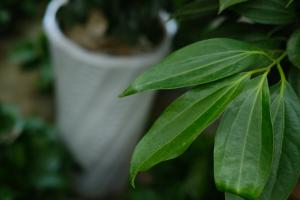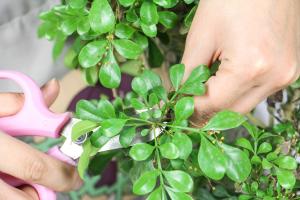Introduction
The rubber tree plant, also known as Ficus elastica or rubber fig, is a popular indoor houseplant that is easy to care for and can grow up to 100 feet tall in its natural habitat. Taking care of a rubber tree plant is essential to make it thrive in your home. In this article, we will show you how to take care of a rubber tree plant, including how to water, fertilize, and prune it properly.
Light and Temperature
Rubber tree plants prefer bright, indirect sunlight, but can also grow in low light conditions. Direct sunlight can scorch the leaves, so it is best to place the plant near a bright window but out of direct sunlight. Ideally, the rubber tree plant likes temperatures between 60 and 80 degrees Fahrenheit. Keep the plant away from cold drafts and air conditioning vents during the winter months to prevent damage to the leaves.
Watering
Rubber tree plants prefer soil that is moist, but not waterlogged. Water the plant when the top inch of soil dries out. Do not overwater the plant as this can lead to root rot. To avoid moisture loss, consider placing the pot on a tray filled with pebbles and water. This will provide a humid environment for the plant. It is also essential to use a well-draining potting soil to ensure proper drainage and avoid excess water retention.
Fertilizing
Fertilizing a rubber tree plant is essential to provide the necessary minerals and nutrients for healthy growth. Use a balanced, water-soluble fertilizer during the growing season, which is typically from spring to summer. Follow the manufacturer's instructions to prevent over-fertilization, as this can burn the roots and damage the plant. Be sure to water the plant thoroughly after fertilization to prevent salt buildup in the soil.
Pruning and Propagation
Pruning a rubber tree plant is essential to maintain its shape and encourage bushy growth. Prune the plant in the spring, just before new growth appears. Use sharp, clean scissors to cut back any dead or diseased leaves, and trim the plant to the desired size and shape. Rubber tree plants can also be propagated using stem cuttings. Take a 6-inch cutting just below a node, remove the lower leaves, and place it in a jar of water. When new roots appear, transfer the cutting to a pot with well-draining soil and care for it as you would a mature rubber tree plant.
Pest and Disease Control
Rubber tree plants can be susceptible to pest infestations and disease. Mealybugs and scale insects are common pests that can be controlled with insecticidal soap. Fungal diseases like leaf spot can be prevented by avoiding overwatering and ensuring proper air circulation. If you notice any signs of pests or disease, isolate the infected plant to prevent it from spreading to other indoor plants. With proper care and attention, your rubber tree plant will thrive and add a touch of natural beauty to your home.

 how many times do yo...
how many times do yo... how many planted tre...
how many planted tre... how many pine trees ...
how many pine trees ... how many pecan trees...
how many pecan trees... how many plants comp...
how many plants comp... how many plants can ...
how many plants can ... how many plants and ...
how many plants and ... how many pepper plan...
how many pepper plan...





























